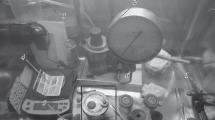Abstract
In the present work, compact samples of pyrophoric nickel nanopowders with an average particle size of 55 nm obtained by the method of chemical metallurgy were investigated. The possibility of passivation of compact samples 3 mm in diameter made of nickel pyrophoric nanopowders in the air is experimentally shown for the first time. The time of complete passivation is only 3–5 s for a relative sample density 0.4–0.5. According to X-ray phase analysis, only Ni phase was observed in passivated samples. It was found that passivated samples maintain thermal stability in the air at slow (< 10 °C/s) heating to ~ 200 °C; it is an important parameter for fire safety at handling of nanopowders. The analysis of passivated samples by the SEM method showed no traces of sintering of nickel nanoparticles, even after testing for thermal stability. The uniform distribution of oxygen within passivated samples according to energy dispersive X-ray analysis data indicates the volumic nature of the interaction of samples with the air during passivation. For the passivated samples, critical heating conditions were determined, under which self-ignition occurs.





Similar content being viewed by others
References
Alymov MI, Rubtsov NM, Seplyarskii BS, Kochetkov RA, Zelensky VA, Ankudinov AB (2017a) Combustion and passivation of nickel nanoparticles. Mendeleev Commun 27(6):631–633. https://doi.org/10.1016/j.mencom.2017.11.032
Alymov MI, Rubtsov NM, Seplyarskii BS, Zelensky Victor A, Ankudinov AB (2017b) Passivation of iron nanoparticles at subzero temperatures. Mendeleev Commun 27(5):482–484. https://doi.org/10.1016/j.mencom.2017.09.017
Alymov MI, Rubtsov NM, Seplyarsky BS et al (2019) Synthesis of Ni nanoparticles with controlled pyrophoricity and mean size. Доклады Академии наук 484(1):48–51. https://doi.org/10.31857/S0869-5652484148-51
Bouillard J, Vignes A, Dufaud O, Perrin L, Thomas D (2010) Ignition and explosion risks of nanopowders. France J Hazard Mater 181(1–3):873–880
Dean JG (1952) Thermal decomposition of nickel formate. Ind Eng Chem Soc 44:985–990
Dong S, Cheng H, Yang H, Hou P, Zou G (2002) Fabrication of intermetallic NiAl by self-propagating high-temperature synthesis reaction using aluminium nanopowder under high pressure. J Phys Condens Matter 14:11023–11030
Flannery M, Desai TG, Matsoukas T, Lotfizadeh S, Oehlschlaeger MA (2015) Passivation and stabilization of aluminum nanoparticles for energetic materials. Hindawi Publishing Corporation J Nanomater 2008(V):185–199
Gromov AA, Teipel U (eds) (2014) Metal nanopowders: production, characterization, and energetic applications. John Wiley & Sons, p 417. https://doi.org/10.1002/9783527680696
Hosokawa M, Nogi K, Naito M, Yokoyama T (eds) (2007) Nanoparticle technology handbook, 3rd edn. Elsevier, p 644. https://doi.org/10.1016/C2017-0-01011-X
Hunt EM, Pantoya ML (2005) Ignition dynamics and activation energies of metallic thermites: From nano- to micron-scale particulate composites. J Appl Phys 98:034909
Meziani MJ, Bunker CE, Lu F et al (2009) Formation and properties of stabilized aluminum nanoparticles. ACS Appl Mater Interfaces 1:703–709
Nagarajan R, Hatton A (2008) (ed); Nanoparticles: synthesis, stabilization, passivation, and functionalization ACS symposium series. American Chemical Society, Washington, DC
Pivkina A, Ulyanova P, Frolov Y, Zavyalov S, Schoonman J (2004) Nanomaterials for heterogeneous combustion. Propell Explosiv Pyrotech 29(1):39
Rubtsov NM, Seplyarskii BS, Alymov MI (2017) Heat and mass transfer, ignition and wave processes in combustion of solids. Springer International Publishing, p 284. https://doi.org/10.1007/978-3-319-56508-8
Saceleanu F, Idir M, Chaumeix N, Wen JZ (2018) Combustion characteristics of physically mixed 40 nm aluminum/copper oxide Nanothermites using laser ignition. Front Chem. https://doi.org/10.3389/fchem.2018.00465
Seplyarskii BS, Ivleva TP, Corresponding Member of the RAS M. I. Alymov (2018) Macrokinetic analysis of passivation of pyrophoric powders. Dokl Akad Nauk 478(3):310–314
Author information
Authors and Affiliations
Corresponding author
Ethics declarations
The study was performed at the expense of a grant from the Russian Scientific Foundation (project no. 16-13-00013P).
Conflict of interest
The authors declare that they have no conflict of interest.
Additional information
Publisher’s note
Springer Nature remains neutral with regard to jurisdictional claims in published maps and institutional affiliations.
Rights and permissions
About this article
Cite this article
Alymov, M.I., Seplyarskii, B.S., Vadchenko, S.G. et al. The influence of heating conditions of the samples of nickel nanopowders on the modes of their interactions with the air. J Nanopart Res 22, 353 (2020). https://doi.org/10.1007/s11051-020-05091-3
Received:
Accepted:
Published:
DOI: https://doi.org/10.1007/s11051-020-05091-3




